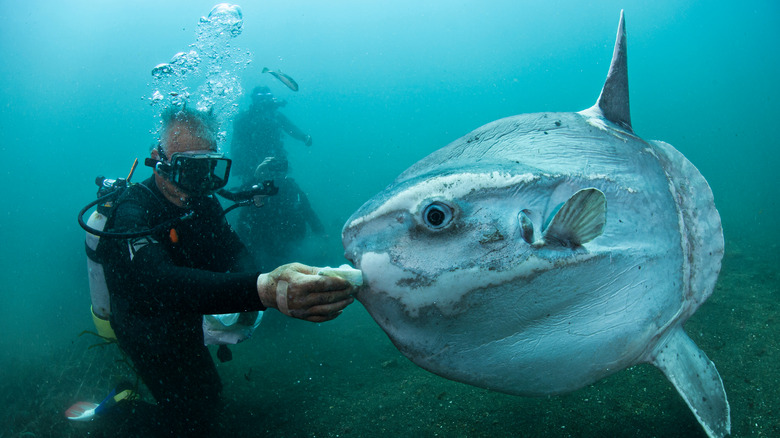The Unusual Way A Record-Breaking Fish Had To Be Weighed
On the surface, fish may not be the most interesting of creatures. As pets, they're not exactly highly interactive and entertaining, unlike your average cocker spaniel. They seem to have mastered two things: coming in a range of exotic colors (sometimes), and swimming in seemingly aimless fashion.
To deny their appeal, however, is to be ignorant of how varied and intriguing fish really are. Piranhas, for instance, are notorious for their voracious appetites and alleged ability to shred prey's flesh down to the bones in the blink of an eye. As Britannica reports, this is a great exaggeration and most piranhas merely scavenge or feed on plants, but the tales have done a lot for the reputation of the species.
The sunfish is another aquatic creature known for a particular unique trait, and this one is absolutely no exaggeration or legend. Per National Geographic, one species, the giant sunfish, is the biggest bony fish ever discovered. Determining with any precision the tremendous size of a specific specimen is a particular challenge.
A truly giant sunfish
Per Newsweek, the ocean sunfish and giant sunfish were considered the same species until very recently. Only in 2017 was it determined that they were separate species. The giant sunfish is largely differentiated by the fact that, as its name implies, it's really, really big. Even more so.
In 1996, Guinness World Records reports, a bump-head sunfish was found in the waters off Kamogawa, Japan. Frankly, it would probably have been rather difficult to miss: at 8 feet 11 inches long and tipping the scales at a remarkable 5,070 pounds (2,300 kilograms), it claimed the record for the heaviest bony fish ever discovered.
Almost three decades later, though, another specimen was found that topped this record by a considerable length. According to CNN, in October 2022, the magnificent creature was dead when it was found, afloat in the region of Faial Island near Portugal. So vast was the sunfish's body that it had to be painstakingly transported back to dry land for an accurate measurement to be made. To do this, the site reports, a forklift truck was used to haul it into position. From there, it was weighed using a crane scale dynamometer. Johnson Scale & Balance Co. states that crane scales are designed for determining the weights of suspended objects, generally very significantly weighty ones. It's specialized equipment, such as would be needed for a very special fish like this one.
A record broken by around half a ton
In 2022, the Journal of Fish Biology published the study "The heaviest bony fish in the world: a 2,744 kg giant sunfish Mola alexandrini (Ranzani, 1839) from the North Atlantic," from Christopher K. Pham et al. The scientists describe the process of weighing this tragic behemoth: "the specimen was raised slowly and kept above the ground for a few minutes in order to allow the exact measurements to stabilize. Crane scale calibration was confirmed before and after the measurements took place."
A tape measure was also utilized to determine the length of the sunfish, the report goes on, and various DNA samples were taken and tests undertaken on the corpse. The results were extraordinary: "the specimen measured 325 cm total length, 359 cm total body length and 86 cm of maximum width ... weighing 2,744 kg." That translates to over 10 feet total length, more than 11 feet total body length, almost three feet in width, and weighing well over three tons.
The study concludes that this particular fish is almost a half-ton heavier than the Guinness World Records previous record-holder. Perhaps there's another sunfish lurking in the oceans that's larger still, but one thing's for certain: These fantastic creatures are truly gigantic.


